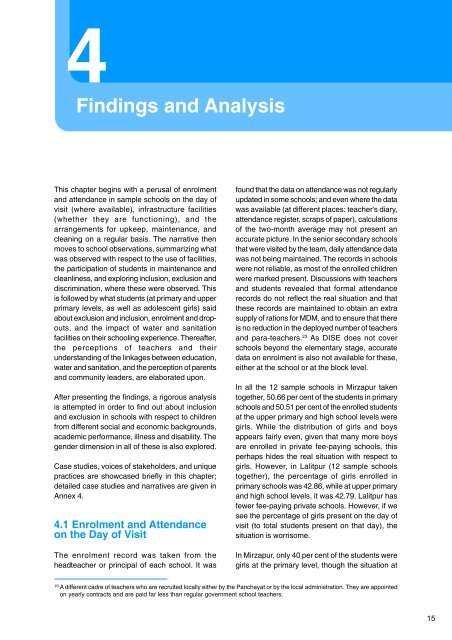Equity in School Water and Sanitation
Equity in School Water and Sanitation
Equity in School Water and Sanitation
Create successful ePaper yourself
Turn your PDF publications into a flip-book with our unique Google optimized e-Paper software.
Overcom<strong>in</strong>g Exclusion <strong>and</strong> Discrim<strong>in</strong>ation <strong>in</strong> South AsiaIndia Country Report4F<strong>in</strong>d<strong>in</strong>gs <strong>and</strong> AnalysisThis chapter beg<strong>in</strong>s with a perusal of enrolment<strong>and</strong> attendance <strong>in</strong> sample schools on the day ofvisit (where available), <strong>in</strong>frastructure facilities(whether they are function<strong>in</strong>g), <strong>and</strong> thearrangements for upkeep, ma<strong>in</strong>tenance, <strong>and</strong>clean<strong>in</strong>g on a regular basis. The narrative thenmoves to school observations, summariz<strong>in</strong>g whatwas observed with respect to the use of facilities,the participation of students <strong>in</strong> ma<strong>in</strong>tenance <strong>and</strong>cleanl<strong>in</strong>ess, <strong>and</strong> explor<strong>in</strong>g <strong>in</strong>clusion, exclusion <strong>and</strong>discrim<strong>in</strong>ation, where these were observed. Thisis followed by what students (at primary <strong>and</strong> upperprimary levels, as well as adolescent girls) saidabout exclusion <strong>and</strong> <strong>in</strong>clusion, enrolment <strong>and</strong> dropouts,<strong>and</strong> the impact of water <strong>and</strong> sanitationfacilities on their school<strong>in</strong>g experience. Thereafter,the perceptions of teachers <strong>and</strong> theirunderst<strong>and</strong><strong>in</strong>g of the l<strong>in</strong>kages between education,water <strong>and</strong> sanitation, <strong>and</strong> the perception of parents<strong>and</strong> community leaders, are elaborated upon.After present<strong>in</strong>g the f<strong>in</strong>d<strong>in</strong>gs, a rigorous analysisis attempted <strong>in</strong> order to f<strong>in</strong>d out about <strong>in</strong>clusion<strong>and</strong> exclusion <strong>in</strong> schools with respect to childrenfrom different social <strong>and</strong> economic backgrounds,academic performance, illness <strong>and</strong> disability. Thegender dimension <strong>in</strong> all of these is also explored.Case studies, voices of stakeholders, <strong>and</strong> uniquepractices are showcased briefly <strong>in</strong> this chapter;detailed case studies <strong>and</strong> narratives are given <strong>in</strong>Annex 4.4.1 Enrolment <strong>and</strong> Attendanceon the Day of VisitThe enrolment record was taken from theheadteacher or pr<strong>in</strong>cipal of each school. It wasfound that the data on attendance was not regularlyupdated <strong>in</strong> some schools; <strong>and</strong> even where the datawas available (at different places: teacher's diary,attendance register, scraps of paper), calculationsof the two-month average may not present anaccurate picture. In the senior secondary schoolsthat were visited by the team, daily attendance datawas not be<strong>in</strong>g ma<strong>in</strong>ta<strong>in</strong>ed. The records <strong>in</strong> schoolswere not reliable, as most of the enrolled childrenwere marked present. Discussions with teachers<strong>and</strong> students revealed that formal attendancerecords do not reflect the real situation <strong>and</strong> thatthese records are ma<strong>in</strong>ta<strong>in</strong>ed to obta<strong>in</strong> an extrasupply of rations for MDM, <strong>and</strong> to ensure that thereis no reduction <strong>in</strong> the deployed number of teachers<strong>and</strong> para-teachers. 23 As DISE does not coverschools beyond the elementary stage, accuratedata on enrolment is also not available for these,either at the school or at the block level.In all the 12 sample schools <strong>in</strong> Mirzapur takentogether, 50.66 per cent of the students <strong>in</strong> primaryschools <strong>and</strong> 50.51 per cent of the enrolled studentsat the upper primary <strong>and</strong> high school levels weregirls. While the distribution of girls <strong>and</strong> boysappears fairly even, given that many more boysare enrolled <strong>in</strong> private fee-pay<strong>in</strong>g schools, thisperhaps hides the real situation with respect togirls. However, <strong>in</strong> Lalitpur (12 sample schoolstogether), the percentage of girls enrolled <strong>in</strong>primary schools was 42.86, while at upper primary<strong>and</strong> high school levels, it was 42.79. Lalitpur hasfewer fee-pay<strong>in</strong>g private schools. However, if wesee the percentage of girls present on the day ofvisit (to total students present on that day), thesituation is worrisome.In Mirzapur, only 40 per cent of the students weregirls at the primary level, though the situation at23A different cadre of teachers who are recruited locally either by the Panchayat or by the local adm<strong>in</strong>istration. They are appo<strong>in</strong>tedon yearly contracts <strong>and</strong> are paid far less than regular government school teachers.15












